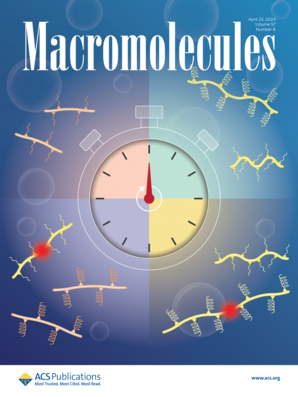Effect of the Second Network on First Network Rupture and the Origin of Energy Dissipation in Double Network Hydrogels
IF 5.1
1区 化学
Q1 POLYMER SCIENCE
引用次数: 0
Abstract
The detection of mechanoradicals generated by homolytic bond scission enables the quantitative determination of the polymer network rupture during deformation in hydrogels. In this study, we investigate, in double network (DN) hydrogels, how the stretchable second network affects the stress distribution and rupture of the first network and how it contributes to energy dissipation by correlating bond scission with mechanical hysteresis. By increasing the second network density while keeping the first network constant, the tensile behavior of DN gels transitions from typical DN characteristics, exhibiting yielding with necking and strain-hardening, to an oversupported state, showing yielding and strain-hardening without necking, accompanied by reduced bond scission in the first network. Notably, the first network bond scission occurs extensively beyond the yield point and saturates at large strains, irrespective of necking behavior. Furthermore, the energy dissipated per bond cleavage remains constant in the necking regime but increases significantly in the strain-hardening regime and rises with higher second network density, indicating dissipation in the second network through internetwork entanglements. These trends are consistent across DN gels with both weak and strong cross-linkers in the first network, with the weak cross-linker leading to greater bond scission. This study not only deepens the understanding of the molecular mechanism underlying DN materials but also assists in designing mechanoresponsive functional materials based on DN mechanochemistry.

双网状水凝胶中第二网状对第一网状破裂的影响及能量耗散的来源
通过检测均裂键断裂产生的机械自由基,可以定量测定水凝胶变形过程中聚合物网络的破裂。在这项研究中,我们研究了在双网络(DN)水凝胶中,可拉伸的第二网络如何影响第一网络的应力分布和破裂,以及它如何通过将键断裂与机械滞后相关联来促进能量耗散。通过增加第二网络密度,同时保持第一网络不变,DN凝胶的拉伸行为从典型的DN特征(屈服、颈缩和应变硬化)转变为过度支撑状态(屈服、应变硬化、无颈缩),同时减少了第一网络中的键断裂。值得注意的是,无论颈缩行为如何,第一次网络键断裂在屈服点之外广泛发生,并在大应变下达到饱和。此外,每次键解理耗散的能量在颈缩状态下保持不变,但在应变硬化状态下显著增加,并且随着第二网络密度的增加而增加,表明第二网络通过网络间纠缠而耗散。这些趋势在具有弱交联剂和强交联剂的DN凝胶中都是一致的,弱交联剂导致更大的键断裂。本研究不仅加深了对DN材料分子机制的理解,而且有助于设计基于DN力学化学的机械响应功能材料。
本文章由计算机程序翻译,如有差异,请以英文原文为准。
求助全文
约1分钟内获得全文
求助全文
来源期刊

Macromolecules
工程技术-高分子科学
CiteScore
9.30
自引率
16.40%
发文量
942
审稿时长
2 months
期刊介绍:
Macromolecules publishes original, fundamental, and impactful research on all aspects of polymer science. Topics of interest include synthesis (e.g., controlled polymerizations, polymerization catalysis, post polymerization modification, new monomer structures and polymer architectures, and polymerization mechanisms/kinetics analysis); phase behavior, thermodynamics, dynamic, and ordering/disordering phenomena (e.g., self-assembly, gelation, crystallization, solution/melt/solid-state characteristics); structure and properties (e.g., mechanical and rheological properties, surface/interfacial characteristics, electronic and transport properties); new state of the art characterization (e.g., spectroscopy, scattering, microscopy, rheology), simulation (e.g., Monte Carlo, molecular dynamics, multi-scale/coarse-grained modeling), and theoretical methods. Renewable/sustainable polymers, polymer networks, responsive polymers, electro-, magneto- and opto-active macromolecules, inorganic polymers, charge-transporting polymers (ion-containing, semiconducting, and conducting), nanostructured polymers, and polymer composites are also of interest. Typical papers published in Macromolecules showcase important and innovative concepts, experimental methods/observations, and theoretical/computational approaches that demonstrate a fundamental advance in the understanding of polymers.
 求助内容:
求助内容: 应助结果提醒方式:
应助结果提醒方式:


